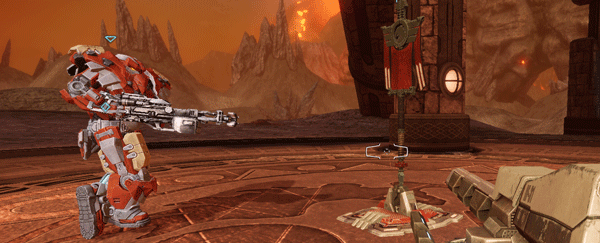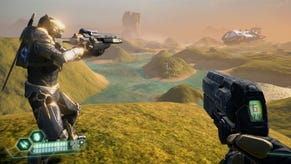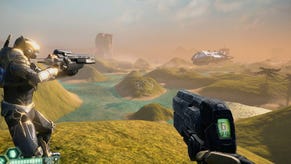Hi-Rez On Tribes' Failings And Future, Tribes Ascend 2
Jetpacking It In
Oh Tribes Ascend, say it ain't so. Sure, we had our ups and downs, but you know you were loved, right? Right?! Just hold on a little bit longer and then-- oh, you're not dying. Just ceasing updates for the foreseeable future, maybe forever. Well, that's still a shame, but I guess I can stop frantically shaking you and screaming spittle into your face. But you know you've left quite a few loose ends, don't you? What about balance concerns, your decision to prioritize buyable items over game-changing updates, the lack of a strong tutorial, support for player-made maps, and the possibility of Tribes Ascend 2? Oh right, I asked Hi-Rez COO Todd Harris about all of that stuff. Handy!
RPS: Tribes isn't receiving any major updates for the next six months - at the very least. Why? Is it just to focus on Smite for now, or has Tribes hit a point where it wasn’t making enough money to continue justifying the cost?
Harris: The number one reason is that it’s actually very content-rich. I can give you the stats. I just pulled up your article, so it sounds like you’re pretty familiar. Since launch, we added 54 new weapons. We added a new game mode, a new leveling system, custom servers, server browser, shielded base assets, 29 new maps – all free – and all that in a brief period of time.
We also added an option for people to pay one price and get all the weapons. I don’t know of any other free-to-play game, other than our own Smite, that has that option. It’s free-to-play, but it does have a twist. You can get all the gameplay elements for the price of a normal game. It’s fairly complete in its content.
The other thing is, the one thing we’re going to be working on next is a path for users to add their own maps. We just feel like it’s at a good point to have users maintain it. That’s reason number one. We feel like it’s a complete experience and we want to give users the tools to add their own maps, as opposed to just adding more guns that wouldn’t benefit the game.
Reason number two, as a studio, even though the game is complete we could do things like additional cosmetics that would really just not affect the core game balance, but be revenue-generating. But we are seeing so much opportunity and growth with Smite that, as a studio, we’re prioritizing that [over that sort of addition to Tribes].
RPS: For user-made content, are you thinking a tool set or a full-blown SDK?
Harris: That’s to be determined. There’s some community work toward an SDK that’s been started. I expect, let’s say, over the next month we’ll see more details on that. It’s not anything that has a date on that, or a full feature set. Other than small bug fixes, that’s the only real new feature we have in the works for Ascend.
RPS: At this point, how much of a priority is it? Is it something you’re thinking of launching after that six-month period? Or are you going to make an effort to release it during the intervening period?
Harris: I think that, ideally, it would be in the intervening time. But it’s a pretty fresh concept. It doesn’t have any committed date yet. There’s a lot of different ways we can go with it, as you would imagine. We just want to let people know that that’s the next thing for Tribes: Ascend.
RPS: You updated Tribes a lot with maps, guns, and buyables, but many people feel as though you haven't addressed issues that are fundamental to the game itself - like an imbalance between offense and defense and the lack of a really in-depth, playable tutorial. Stuff that makes it harder for people to get into and enjoy the game.
Harris: We hear that feedback a lot, so I’m not surprised, and it may be valid for those people. But we think, again, that the game and the features stand out well. A tutorial, a lot of people talk about tutorial. It’s really hard to make an exceptional tutorial. I haven’t found gamers to be all that fond of tutorials in general. I think with Tribes, the gameplay is different enough that either people have played it before, or they have friends that are playing, and that kind of gets them over the long learning curve. I think that even if we spent a lot of time on a tutorial, that would be a very modest improvement as far as new people sticking with the game.
RPS: But especially when a game is "finished" like this - when the balance probably won't shift radically - it seems like a good time to introduce a tutorial that teaches battlefield roles, weapon strengths and weaknesses, movement techniques, etc. Especially in a game with as many little nuances as Tribes.
Harris: Yeah. Again, I just… In my mind, it’s just a different enough game that I kind of think people are either motivated to get the skiing and the shooting and the leading their opponent, or they’re not. That’s actually the thing that’s the most different for people that aren’t familiar with it. I agree with your point, that class-specific tutorials and those sorts of things… Any of that would be helpful. But the community has done a lot of class-based videos and those resources are available. Again, we’re at this point more about empowering the community to make content, versus those sorts of features.
RPS: That in mind, who did you end up making Tribes: Ascend for? Was it more for people who used to be into Tribes 2 back in the day, or was it to get new people who have never really played a Tribes game into the series?
Harris: Definitely both.
RPS: But you thought new players would just be self-motivated enough to learn everything, even though they usually aren't? Do you think that you ended up in kind of an awkward position in trying to cater to both crowds? I mean, I think it's possible, but the issue seems to be that newer people have trouble getting into it while long-timers aren’t necessarily fans of the way the base defense and things of the like are done, because you've simplified them for newer players.
Harris: Yeah, but I don’t think it’s weird. I mean, more people have played it than all the previous Tribes games, certainly. A lot of people are continuing to play it and still, at this point, continue to discover it. I just think it’s different enough from military shooters that, if you look at a lot of older-school shooters, like the recent Quake Live or Unreal III, there’s a group that enjoys them and a group where it’s not for them.
Tutorials and things could make a modest improvement, but ultimately it’s whether people enjoy that core gameplay or not. We tried to preserve what we thought the core gameplay was, the best elements in Tribes and Tribes 2 and, to a lesser extent, Tribes Vengeance. Players all have their own opinions. But we tried to preserve that and I think we did. We tried to bring that to as many people as possible. I think a lot of new people have discovered it. But ultimately, it’s not for everyone. I just think that a tutorial would make only a modest improvement on that.
RPS: Where do you think Tribes Ascend still stands to be improved?
Harris: The party system came a little bit late in development. Good social systems, so that you’re inspired to keep playing with your friends, help people stick. Some idea of ranked play, I think, would have helped. We had, and still have to some degree, an eSports scene with teams playing for money, and then you have pub play. It’s hard to bridge that gap without a gateway system that feeds from pub play to more competitive play. A lot of that has to happen outside of games.
That, I think, is an example of something that potentially could have helped. That’s the sort of feature that, again, we don’t think makes sense to introduce into Ascend at this point, as opposed to just letting users make maps. Which is really the main thing we hear from the community. Certainly the vets have various issues, whether it’s in relation to offense or defense, or people don’t like the physics implementation, but what I overwhelmingly hear from the people that are playing at this point is that they really enjoy what’s there, but they would like a way to make maps and a path to do that. That’s what we’re trying to address.
RPS: There’s the other side of the argument, too, which is that games that have been updating for eons - things like Team Fortress 2 and World of Warcraft - lost some of their original spirit. Some longtime players no longer like those games, because they changed too much from the core of what they were.
Harris: That’s right as well. You know how game communities are. With each of our updates… Early on they were very significant, and there might have been some complaints around how it was too much new stuff at once. You do get both. Ultimately I think that if you look at, whether it’s the reviews of the game, combined with the fact that people can pay a very reasonable price, in line with other multiplayer shooters, and get everything in there… The fact that you can do that and get a very well-reviewed game and get all the content in it, that leaves it at a point where we feel good about what we’ve delivered. But the number one community feedback we’ve been getting is around a path for user-generated content. We’re trying to respond to what we’ve heard the users ask for as most important.
RPS: As far as the offense and defense stuff, things like that, issues at the core of the game itself, do you worry at all that discontinuing major updates at this point will shake your harder-core player base’s faith in your company? Especially since you instead chose to focus on so many things that players could buy?
Harris: It’s a good question. I don’t think so. We feel good about the core. Rock Paper Shotgun, as well as most other media, reviewed the game extremely highly. I think it’s the highest-rated free-to-play released game. Team Fortress 2 has a higher score, but they weren’t free-to-play when they released. It’s made numerous top-10-shooters-of-all-time lists. Combining that with the idea that the core is somehow broken, we just don’t really get that. We get that certain vets of other games find it different from those games, but those folks, I think, long ago decided that it was enough like Tribes that they were going to play it, or that it wasn’t. We’ve kept that stuff pretty core.
RPS: When you first announced Tribes' sleep of a thousand sleeps, you mentioned that a Tribes Ascend 2 would actually be more likely than more major updates to the first one. Why?
Harris: Well, as you saw, I clarified that no one was working on that. I was trying to indicate that, long-term, I and we just think it is a strong franchise. There are other places that it could go. But per your point, let’s say there was a desire to [make sweeping changes]. Whether it’s to introduce a kind of ranking or some aspect of the core that did change, but we didn’t want to upset or disenfranchise the current group. That was really my thought. The days of major changes in the game are behind us.
We want users to be able to add content, and if there was anything really significant that was to change, that would be in a different title. We won’t be changing the rules on all these people, changing what they’re used to. But again, our priorities right now are, for Ascend we want to give people the chance to make content. Other than that, our studio is focused on Smite, because it’s growing much faster than any game that we’ve dealt with. At the highest level that’s what we’re focused on. That was the intent of the statement. First, to let people know we weren’t going to be doing any other major updates, and then, just today, in talking with the community, to let them know our intent around support for user-generated content.
RPS: So is Hi-Rez finally dialing in its focus to make the best of one game? Do you think you maybe juggled a bit more than you could handle previously?
Harris: Well, we have three small teams. We’ve tried to do more than one at a time. But I think the best results come when we’re more focused. Basically, each game has gotten the degree of focus that the community has brought in. Very specifically, all Tribes profits have gone into enhancing Tribes with its updates. Now Smite is doing well enough that it’s justifying a large amount of resources on it. Commercially, both projects have been supporting themselves. From a degree of focus perspective, I think more focus helps us as a studio. We see the biggest studio opportunity on Smite.
Smite is growing incredibly fast and, as a studio, we’ve learned the value of focus. So other than Tribes mod/map support, our focus is all-in on Smite for next six months.
RPS: Thank you for your time.













